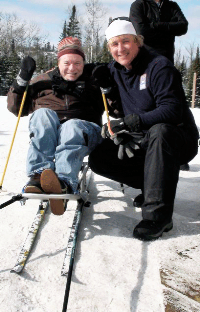
Dave Shannon (LLB’91): Beyond Limits
Some people will go to great lengths to promote breaking barriers to accessibility and greater community inclusion for people living with disabilities. David Shannon (LLB’91) opted to go to the North Pole to achieve that goal.
It’s a pretty impressive feat, and one that would capture a lot attention, but it’s even more impressive when you discover that Shannon made it to the top of the world in a wheelchair.
Under the banner of ‘Team Independence ’09,’ and with assistance from expedition co-leader and fellow lawyer Chris Watkins, Shannon became the first person ever with quadriplegia and in a wheelchair to reach the Pole. To celebrate this landmark achievement, he and Watkins planted a Wheelchair Access Parking sign, along with flags representing the United Nations, Canada and Ontario.
Changing perceptions
“This sign represents all people who have faced challenges or adversity in their lives and have dreamed of overcoming them,” explains Shannon. “If we as people work together in our homes, our cities, our countries and in our global village, there is no dream that cannot be realized.”
Shannon is living proof of that. Only 18 when a rugby practice injury resulted in the loss of mobility from the neck down, he has dedicated his life to changing public perceptions about what people with disabilities can do if they have the opportunity to try.
“For me, human rights is a lifestyle. I know the germination was there before my accident, but it particularly created the focus of wanting to understand what creates equality for all and how that can be preserved.”
You can see that determination in his North Pole trek, which posed considerable challenges for Shannon. Having no feeling in his lower body, he had to be well protected from the elements to ward off frostbite and infection. Shannon’s team also developed a sled for his wheelchair so it could cross arctic ice, and he used adapted walking sticks to propel himself forward, with Watkins pulling on a tether. All in all the preparation for the journey took two years.
Raising awareness
But what do you do after you’ve gone to the top of the world to raise awareness of accessibility rights and inclusion? You keep pushing for change, which Shannon is doing now as director and CEO of the Nova Scotia Human Rights Commission. The Dalhousie graduate took on the position in January 2012 and credits the skills he learned as president of the student union, and the grounding he had in human rights through his legal studies, for providing him with all the preparation he needed.
“Dalhousie gave me confidence to pursue the legal profession and also to fully participate in my community.”
As for his goals in leading the Commission, Shannon says: “I want to position it as the body that will work with all communities and organizations, both governmental and non-governmental, to support the human rights act, and that means to promote the dignity and sense of self-worth of all Nova Scotians.”
Given that Shannon has been to the North Pole, there’s little doubt he can make it happen.